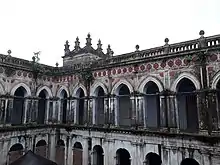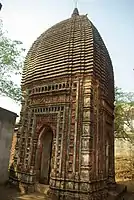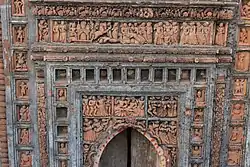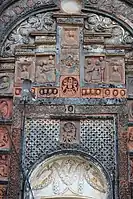Hetampur
Hetampur is a large village[1] in Suri Sadar subdivision of Birbhum District in the Indian state of West Bengal. It is situated near Dubrajpur. The village is famous for the Royal and historical palace and reputed college.[2]
Hetampur | |
|---|---|
Town | |
 Hetampur Raj Palace | |
 Hetampur Location in West Bengal, India | |
| Coordinates: 23.781936°N 87.403346°E | |
| Country | |
| State | West Bengal |
| District | Birbhum |
| Population (2011)[1] | |
| • Total | 2,388 |
| Languages | |
| • Official | Bengali, English |
| Time zone | UTC+5:30 (IST) |
| PIN | 731124 |
| Telephone/STD code | 91 3462 |
| ISO 3166 code | IN-BR |
| Lok Sabha constituency | Birbhum |
| Vidhan Sabha constituency | Dubrajpur |
| Website | birbhum |
Geography
| Cities and towns in Suri Sadar subdivision of Birbhum district M: municipal city/ town, CT: census town, R: rural/ urban centre, B: Barrage. Owing to space constraints in the small map, the actual locations in a larger map may vary slightly |
Location
Hetampur is located at 23°46′55″N 87°24′12″E.
History
The earlier name of the place was Raghabpur, named after Raghab Roy, who was a Zamindar of the place under the Royal Kings of Rajnagar. Murshid Quli Khan, Nawab of Bengal, came, on the request of the Rajnagar kings, to tame the rebellious Raghab Roy. The latter was defeated and he fled. Thereafter, Hatem Khan became Zamindar, of this place and it was renamed Hatempur. With the passage of time it became Hetampur.[3] It is said that Hafeez Khan, a soldier, had an affair with a royal princess of Delhi. He fled from Delhi along with the princess and was provided refuge by Hatem Khan. He followed the latter as jaigirdar of Hetampur.[3]
Hetampur Royal Family

The House of Hetampur Raj rose from obscure origins to the status of the most powerful Kingdom and later Zamindari of Birbhum district.[4] Muralidhar Chakraborty, an ancestor of the Hetampur Raj family, emigrated from Bankura district to Birbhum in the late seventeenth century. He first worked in a menial job under the Muslim Zamindar of Rajnagar. His son, Chaitanya Charan Chakraborty, was brought to Hetampur by Hafeez Khan, the Fouzdar (Military Commandar) of Hetampur fort, some fifteen miles south-east of Rajnagar kingdom.[4]
His son, Radhanath Chakraborty, was actual founder of Hetampur Raj family. He subdued the Roy family of Hetampur, who were then Gomasta (Secretary) and Ijaradar (Lease Holder) of Birbhum Raj. Between 1781 and 1799 he undertook Lease of 19 Mouzas of Birbhum Raj and captured some in battles with them. He purchased several Mahals (Zamindari Area) from Murshidabad Nawab when they were put up for auction but never paid taxes and declared freedom from Muslim rule. During the period he had a decisive war with Rajnagar and became independent Bengali King of Birbhum and nearby areas. In the end, he brought the Roy family on his pay roll. When he died in 1838, the net income from his property was Rs. 20,0000.[4]
Raja Bipracharan, son of Radhanath was the most successful ruler. Within seven years of his father’s death, he made his Kingdom, the largest in Birbhum. He lent Rs. 50,000 to Bibi Rajibunissa of Rajnagar Raj family and in return secured more lands. He also ruled over extensive areas in Santhal Parganas.[4]
In 1875, Northbrook conferred on Ramranjan Chakraborty, grandson of Bipracharan, the title of Raja in British India. Two years later he was raised to the position of Raja Bahadur by Lord Lytton. In 1912, he was elevated to the rank of Maharaja.
Demographics
As of the 2011 Census, Hetampur had a population of 2,388; 1,188 males and 1,200 females, giving a ratio of 1010 compared to the West Bengal state average of 950.[1] There were 282 children aged 0–6 and a child sex ratio of 1104, compared to the West Bengal state average of 956.
Hetampur village had a literacy rate of 76.21%, compared to 76.26% of West Bengal- male literacy was 84.82% and female was 67.59%[1]
Education
At Hetampur Krishna Chandra College, popularly known as Hetampur Mahavidyalaya is one of the reputed and oldest college of the West Bengal. There are also few schools and training institutes such as Hetampur Raj High School, Hetampur Girls’ High School, St. Andrus, Hetampur Model School, DAV Public School, Rabindra Najrul Smrit B. Ed College, Hetampur Rajbati Primary Teachers Training Institute etc.[5]
Culture
Rajbari
The Rajbari was built in the shape of a castle with 999 doors which has given it the name Hetampur HajarDuari. (hajar is one thousand in Bengali, duari means doored). Hetampur Rajbari has been used by film directors such as Satyajit Ray, Mrinal Sen, Tarun Majumdar, Raja Sen, Dilip Roy, Sandip Ray, and others in many Bengali films – Goopy Gyne Bagha Byne, Abhijan, Mrigaya, and Ganadebata.[6]
Temples
Hetampur has many interesting terracotta temples in various styles of architecture. During the late 1940s till about 1952 Indian artist Mukul Dey conducted detailed photographic survey of Birbhum-Barddhaman group of terracotta temples. He visited Hetampur and photo recorded the Gol-Mandir, the Chandranath Shiva temple and the Dewanji temples here. Chandranatha Siva Mandir in Hetampur of Dubrajpur, Birbhum built in 1847 is Octagonal pinnacled - Naba Ratna type with terracotta on three sides. Dewanji Mandir nearby is tightly ridged Rekha type with small terracotta facade of 19th century Birbhum-Barddhaman style having rich terracotta on two sides. Out of these three temples, the Gol-Mandir temple is no longer in existence at Hetampur. Its memory survives only in the photographs by Mukul Dey. A portrait of Queen Victoria, European nuns and priests form the theme of decoration on a 19th-century temple in Hetampur.[7]
Temple picture gallery
 Dewanji temple
Dewanji temple Terracotta carvings in Dewanji temple
Terracotta carvings in Dewanji temple Chandranath Shiva temple
Chandranath Shiva temple Terracotta carvings at Chandranath Shiva temple
Terracotta carvings at Chandranath Shiva temple
Fair
Bipracharan Chakravarty of the Hetampur Raj family started a Saraswati Puja at Hetampur. His grandson, Ramranjan, started a 3-days fair on the occasion. The fair continues on the grounds of the Hetampur Rajbari. Gurusaday Dutt had once presented raibeshe bratachari during the fair. Many renowned personalities were invited to attend the fair and some of them came. Hetampur Royal Theatre and Ranjan Opera had their inaugural shows at the fair.[3]
References
- "Hetampur Population - Birbhum, West Bengal". Census 2011. Retrieved 1 September 2018.
- "Hetampur". Birbhum district administration. Retrieved 24 August 2007.
- Mukhopadhyay Aditya, Birbhumer Mela, Paschim Banga , Birbhum Special Issue, February 2006, (in Bengali), pp. 203-214, Information & Cultural Department, Government of West Bengal.
- Gupta, Dr. Ranjan Kumar, The Economic Life of a Bengal District: Birbhum 1770 – 1857, pp. 95 – 101, The University of Burdwan, 1984.
- {{cite B.Ed. -Rabindra Najrul Smrit B.Ed. College web | url = http://www.hetampurrajbatiptti.org/aboutus.html | title = Hetampur Rajbati Primary Teachers Training Institute| accessdate = 2007-09-16 | last = | first = | work = | publisher = Hetampur Rajbati PTTI}}
- "Where history speaks in whispers". The Statesman, 20 January 2007. Retrieved 16 September 2007.
- "Mukul Dey Archives". Chitralekha. Retrieved 16 September 2007.